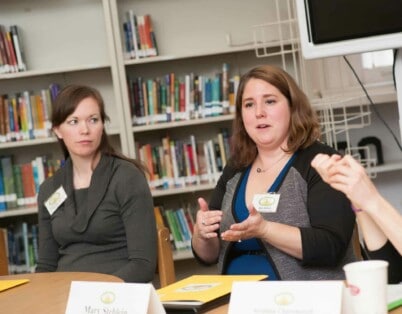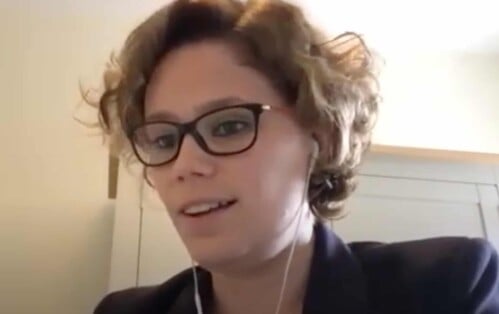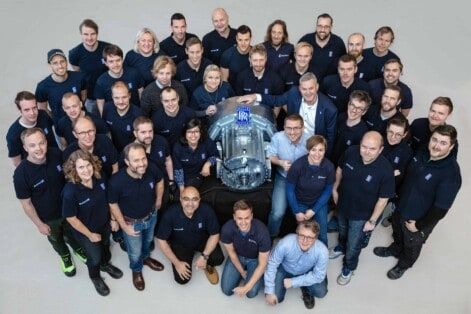Many years ago, a young marine biologist wrote a letter to famed explorer, ocean conservationist, and Renaissance person Jacques Cousteau, asking if she might study with him. He said yes, and she spent a life-changing four months studying the effects of pollution on marine life in the Mediterranean Sea.
Since then, Laurie LaPat-Polasko, Ph.D., has branched into civil and environmental engineering, microbiology, and genetic engineering and has traveled the world, developing sustainable ways to clean up water and soil through microbial bioremediation. Currently vice president and national director of bioremediation for Matrix New World Engineering, she sees the sheer scope of the damage caused by chemical pollution — and offers hope and action to address it.
“To get microbes to biodegrade a contaminant, we need to understand what’s critical to their environment that will let them perform certain metabolic reactions,” Dr. LaPat-Polasko said. “Biochemistry and enzymes decide whether something can be biodegraded. But a lot of contaminated sites lack some of the major nutrients that allow bacteria to biodegrade substances. Just like we need nitrogen and phosphorus to make our ATP enzymes, bacteria need the same key nutrients.
“Now we have the tools to find very specific microbes that we know have the enzyme that biodegrades a certain contaminant, be it plastics or something else, and then we can look for that gene. So when we have the gene and the enzyme that codes it, we can take samples and see if that gene is present in the soil population.”
Dr. LaPat-Polasko pointed out the exponential growth of knowledge in the decades since her early experience with the Exxon Valdez oil spill. “It’s just like how DNA research and CRISPR revolutionized genetics,” she said. “Now we can actually engineer microbes to make them work faster and better. My daughter’s doing her Ph.D. in environmental engineering, and now she’s taking a microbe that degrades one contaminant, then splicing in a gene from another microbe so it can biodegrade two contaminants. Super cool! If you like puzzles, this is one of the best in the world.”
Cleanup time
Since the COVID-19 pandemic began, consumption of single-use plastics has increased by 250–300% in the U.S. alone, according to the International Solid Waste Association, adding to the mountains already choking landfills and waterways. The chemical compounds used to make plastic bags, Styrofoam, and bottles have deeply infiltrated our water and soil, even our bodies, for decades and they include polycyclic aromatic hydrocarbons (PAHs).
Dr. LaPat-Polasko described the PAH bioremediation of a coal gasification manufacturing plant’s contaminated site. She and her team collected soil samples and identified microorganisms in the native environment that might biodegrade the contaminants.
“Often, contaminants might not be readily used by the native microbial population, or there’s too few microbes there to make a difference,” she said. “At that site, we started applying a little bit of soybean oil surfactant to make the contaminant more bioavailable. Soybean oil also provides an easy-to-degrade carbon source that quickly increases the microbial population. As the oil starts to dissipate, some of those microbes start hunting for other carbon sources in the environment. And that’s when they go after the PAHs.”
The third phase of the PAH cleanup involved a 16-plot field-scale bioremediation system, which reduced total PAHs by 80% in only 16 weeks. Can this method be scaled up to Superfund-level sites? “It will be,” she said.
More mighty microbes
Stanford and other universities are looking at ways to biodegrade plastics, and many of them are investigating microbes, even fungi. “Fungus has powerful enzymes,” Dr. LaPat-Polasko said. “If you put a Styrofoam cup in soil and cover it with fungus, it’ll slowly degrade over time. What’s quicker is solubilizing the cup to its chemical elements, until it’s kind of a liquid form that’s more accessible to microbial populations.”
While studying at Stanford University, Dr. LaPat-Polasko isolated a bacteria that degrades methylene chloride, a carcinogen in drinking water. “I thought that was the coolest thing in the world,” she said. “But I wanted to make the microbe work better and faster, which led to a Ph.D. in microbiology and genetic engineering.”
For 25 years, Dr. LaPat-Polasko, who received SWE’s Prism Award in 2020, has spent 90% of her time designing bioremediation systems for soil and water, including projects in Brazil, Australia, and Europe, for many types of chemical contaminants. One dangerous group, perfluorinated compounds (PFACs), has captured her attention, and she’s working with a number of universities to find microbes to biodegrade them.
Her overarching goal is to clean up sites as quickly as possible with sustainable and green remediation. “For 40 or 50 years, we’ve been pumping out tons of groundwater for pump-and-treat systems, which really takes a lot of energy,” she said. “Often, it was just taking the contaminant out of the water and transferring it to activated carbon. Then it would regenerate or be sent to a landfill, and those are not sustainable approaches.
“As time goes on, we’ve realized that bacteria, fungus, and microbes have a lot more power than we knew. We’re getting much better at harnessing their abilities. Everybody said we could never degrade PFACs. They said the same thing 30 years ago about chlorinated solvents, and now I do in situ bioremediation of trichloroethylene all the time. Over time, we’re getting better and smarter.”
Managing pollution from increasing storms
Mary Steblein, P.E., of LaBella Associates, is a project manager and senior civil engineer intent on environmental health. “In high school, I joined a health, safety, and environment program run by Eastman Kodak. We toured their wastewater treatment plant, and it really opened my eyes to how engineers help control pollution and assist the environment. Right then, I committed to ensuring the environment doesn’t get any more damaged than it needs to be by our existence on this planet.”

Today, Steblein’s work revolves around another problem complicated by climate change: more precipitation that starts out relatively clean and gets polluted as it hits the ground. “Stormwater is basically any runoff that doesn’t get a chance to soak into natural materials, such as a wooded area or a lawn,” she said. “It’s generally flowing over impermeable surfaces, so any time you build a new parking lot or a new building or even a new driveway, water has to roll off it and go into some sort of receptacle.”
Runoff picks up pollutants along the way — phosphorus and nitrogen from pesticides and fertilizers, bacteria, oil and waste materials from cars sitting on parking lots, plus sediment from construction sites, and litter.
“Stormwater conveys all these materials into rivers, streams, and lakes, unlike wastewater from homes, which goes to a treatment plant,” Steblein, a certified professional in erosion and sediment control, said. “We do everything possible to provide treatment whenever we have new development, to try to keep those pollutants out of our waterways.”
With more frequent, intense, and potentially higher-saturation storms, current infrastructure can be overwhelmed. “Our regulatory framework is taking this into consideration,” Steblein said. “For example, here in New York, we reference Cornell University’s extreme precipitation website. When we’re designing, we look at numbers for more recent rainfall and plan for the way storms are changing.”
Green infrastructure
Thermal pollution also impacts stormwater. Warmer temperatures make impermeable surfaces such as pavement and cement hotter. Runoff absorbs some of that heat as it travels, transferring it to streams and lakes. There, it affects wildlife, adding more nutrients to those already present, and upsetting delicate ecosystems. Red tides and toxic algae blooms are prime examples.
“There are two different ways to approach this,” Steblein said. “Most of my job lately focuses on regulation compliance when new development or redevelopment is under construction. In New York, we follow the EPA standards, so we design to a menu of practices.”
In recent years, this menu has begun to include “green infrastructure” practices that help treat stormwater right at the source. “If you treat at the source, you’re not piping it hundreds of feet to a retention pond to keep it from blowing things out downstream,” Steblein said. “Green infrastructure uses soil and filtration to clean stormwater, letting it recharge the groundwater instead of running off. It helps keep the base flow in streams where it should be, so that you’re not seeing the effect of development further downstream.”
Rain gardens such as the ones at private homes and properties, only scaled up for larger developments, such as residential complexes and mall parking lots, also have a role. Rain gardens are simple-to-maintain, planted areas where stormwater collects and soaks into the soil, helping clean and keep it where it falls.
“Constructed wetlands are another green infrastructure practice we are involved with, and engineers have a prescribed way of constructing and designing them that is proven to provide stormwater treatment,” Steblein said.
“Our understanding of stormwater is evolving, and regulations are doing their best to keep up, but it also means that everyone else — town planners and boards, engineers that design and review the plans — has to get up to speed,” she added. “The process doesn’t move very fast, but it’s continuously moving in the right direction.”
Nourishing Next-Gen Curiosity
“The take-home message no matter what age kids I work with, is that anything’s possible. You just have to be willing to put yourself out there,” said Laurie LaPat-Polasko, Ph.D., vice president and national director of bioremediation, Matrix New World Engineering, describing one of her most effective outreach exercises for first grade through graduate students.
“For kids to appreciate and understand environmental pollution, they need to get their hands dirty. So I bring a blowup swimming pool, cooking oil and food colorings, and a lot of different equipment — [personal protective equipment], hard hats, suits, gloves, and respirators. I start by telling them that we’re all ‘doctors of the environment.’ And we’re going to clean up a gulf oil spill.”
She brings equipment, such as turkey basters, sponges, and absorbent materials, then splits the students into teams to figure out the cleanup. “Before they start, I talk about different ways to do it — the turkey baster represents big trucks that vacuum up as much contamination as they can,” Dr. LaPat-Polasko said. “Kids of all ages try to suck up this cooking oil with turkey basters, and it’s hilarious. I also bring long sponges, like the booms we use to contain surface spills. Then I ask for their ideas: ‘What else do you think we can use?’ Their creativity and ingenuity is amazing.”
A SWE member for more than 20 years, Mary Steblein, P.E., is actively involved in the Rochester Section. Her outreach through SWE includes “tool clues” badge workshops where engineers show kids the tools they use, and they try to guess the engineer’s job. “I show them my plans, engineer’s scale, and hard hat, things I might need on a typical day,” said Steblein, a project manager and senior civil engineer with LaBella Associates. “It wasn’t until I got into the working world that I ever saw a set of engineer’s plans. Early exposure is really important; kids need to see the tools of work.”
Steblein has been counselor for the Rochester Institute of Technology’s SWE section since 2003. She also keeps in touch with university students through SWE. “I want to make sure they know it’s an option for them after college.”
The higher she flies in aerospace engineering, the more Riona Armesmith, chief project engineer, hybrid-electric propulsion for Rolls-Royce, thinks about the next generation. “When I was more junior, I did a lot of engineering education outreach, going into pre-university schools to get girls interested. There was a young girl back then who got a job at Rolls-Royce without knowing I worked there. When we met again, she said I was the reason she went into engineering, and that — it was the best feeling, to be honest.”
Currently, Armesmith mentors young engineers who reach out online and early career women at Rolls-Royce. “I didn’t really have any role models when I was younger. But I did have a woman physics teacher, who took me to a Women in Engineering event, where women from the Royal Air Force, and one from Goodyear, spoke. They made it sound so exciting, I knew engineering was what I wanted to do. Remembering that impact, I want to go back and do that for others — girls of all ages.”
Hybrid electric propulsion for clearer skies
Riona Armesmith, chief project engineer, hybrid-electric propulsion, for Rolls-Royce, and who also leads the company’s new department, aviation futures, thoroughly enjoys her job. “This slightly expanded role reflects a range of technologies and more and more exciting potential for aerospace,” she said. “Recently I’ve led the E-Fan X hybrid-electric propulsion project, which is now called Power Generation System 1 (PGS1). We’re continuing development of all the technology for making hybrid electric propulsion work.”

Rolls-Royce was in the final stages of constructing a new test bed facility for determining its hybrid-electric engine capabilities when the pandemic hit, further complicating the ability of a global team split across the U.K., Norway, and the U.S. to deliver a novel propulsion system without in-person contact. “COVID has pushed us further into agile work methods, something we’d already been moving toward. In some ways, we found that it’s easier to work globally from home, and things like conference calls become a more level conversation. Agile development has been good for our complex engineering R&D.”
It takes a lot of power to lift an aircraft into the sky, much more than to keep it there. In U.K. terms, each PGS1 2.5 MW engine can generate enough electricity to power 2,500 homes. And all that power poses some major challenges.
“The biggest challenge for any form of electric or hybrid-electric propulsion in aerospace is the weight of the energy storage,” Armesmith said. “Whether it’s batteries or another storage device, like hydrogen fuel cells, the system’s weight is heavier than jet fuel by orders of magnitude. The automotive market faces this too, but less so, since they’re not trying to get a car to lift off the ground.”
Whatever type of hybrid system emerges, there will be compromises. Simply retrofitting today’s aircraft means either carrying fewer passengers or carrying less fuel and losing range. What kind of compromise is economically viable when aircraft companies are already struggling?
Heat-generation management is another big challenge. “Obviously, you’re designing the electrical systems, motors, generators, cables to be as lightweight and efficient as possible,” Armesmith said. “At the megawatt scale, losing just a few percentage points of efficiency means quite a lot of heat to take out. With electrical systems, that heat can’t be very hot, unlike turbines, where the heat out is enormous. Especially in power electronics, there are real stop points to stay under; otherwise, you’ll destroy that device.”
Not exceeding those limits will be difficult, especially in a warming climate. “If it’s a very hot day on the ground and you’re putting heat out over a heat exchanger, you’re just exchanging it with more heat, and it’s harder to get off the ground,” Armesmith said. “We’re working on truly novel thermal management in order to deal with those issues.”
Poised on the edge of possibility
Armesmith and the PGS1 team are at a point where motors, generators, and electronics have reached an exciting phase of the test work. “This is where we really find out if a 2.5 MW, 16,000 rpm, very-high efficiency electrical machine for aerospace is possible, or if we need to go back to the drawing board and find what we missed. Once it’s proven, the electrical system will be placed on an engine in the test facility for the first time. There’s no previous data to validate the computer models — we have to see if our models actually work.”

If they do, the next conversations will be about what level of aircraft modification can be negotiated. “Will companies retrofit for a novel propulsion system?” Armesmith wondered. “Do you change the wing, try to remove some of the existing hydraulic systems on board, and integrate the electrical network of the aircraft and the propulsion system electrical network, or will it be based on archetypes — already knowing the relative risks and trade-offs? There are economic factors to balance with the needs of society, going forward. And — as with everything aerospace, when you radically change the aircraft and propulsion system — it must be proven safe.”
Armesmith also sees potential for hydrogen-based and hybrid-electric with hydrogen propulsion being developed simultaneously. “It’s going to be interesting to see how that plays out,” she said. “I don’t see why you couldn’t hybridize hydrogen gas turbines, either. There are many technical challenges around hydrogen and hybrid electric, but one of the biggest is producing enough green hydrogen, sustainably.
“But there could be a very interesting technological leap forward if these issues can be solved.”









